United States Tank Trucking Market Size
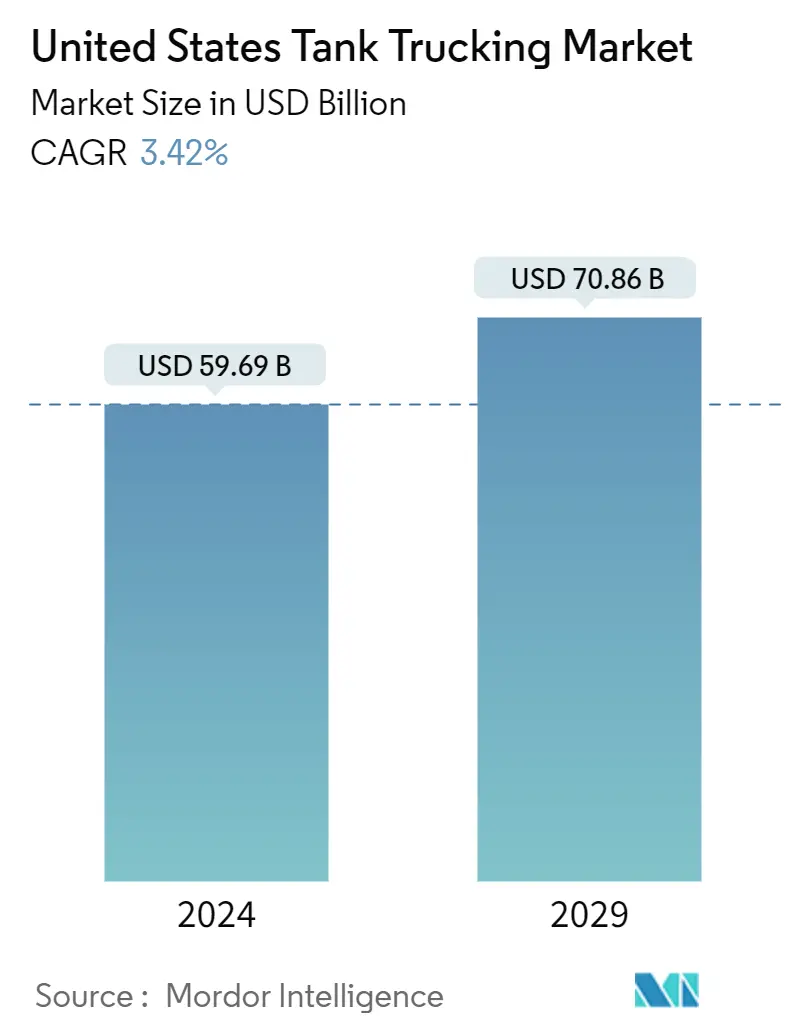
| Study Period | 2020 - 2029 |
| Base Year For Estimation | 2023 |
| Market Size (2024) | USD 59.69 Billion |
| Market Size (2029) | USD 70.86 Billion |
| CAGR (2024 - 2029) | 3.42 % |
| Market Concentration | Low |
Major Players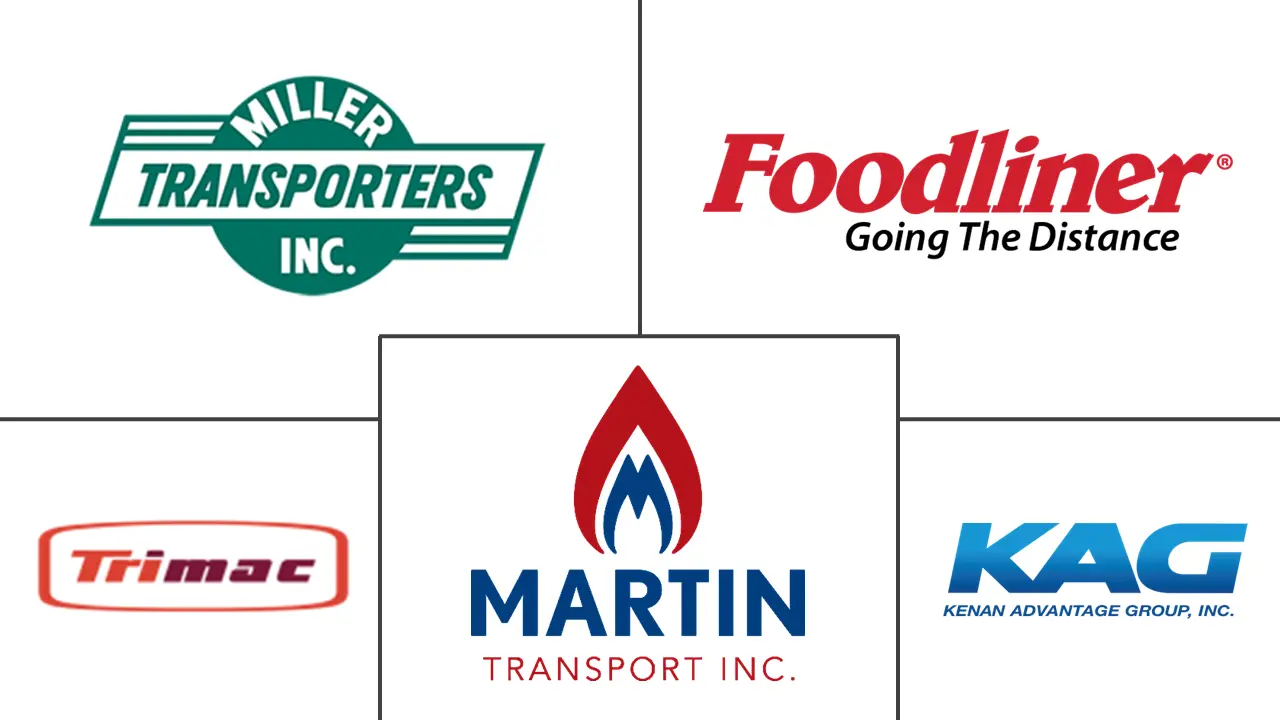
*Disclaimer: Major Players sorted in no particular order |
United States Tank Trucking Market Analysis
The United States Tank Trucking Market size is estimated at USD 59.69 billion in 2024, and is expected to reach USD 70.86 billion by 2029, growing at a CAGR of 3.42% during the forecast period (2024-2029).
- Several factors contribute to the growth of the US tank trucking market. A stronger economy, technological advancements, and increased production and trade of gas, oil, and chemical products drive the market’s expansion. Tank trucks are important in transporting goods to inaccessible areas by rail or pipeline, increasing demand. Furthermore, the slow recovery of the US construction industry and growth in healthcare infrastructure are expected to drive market growth.
- Tank trucks are essential for transporting hazardous chemicals and must adhere to the United States' stringent regulations and safety standards. Operators in this sector handle a wide range of specialty items, including heavy machinery, frozen food, automobiles, and gases that cannot be transported using standard trailers. The industry's performance is closely related to fluctuations in American industrial activity and consumer spending habits.
- Despite its growth potential, the sector encounters hurdles from global and domestic market uncertainties, including escalating borrowing rates, inflationary pressures, and the looming specter of a recession. The projected worldwide downturn in crude oil prices over the next five years poses a threat to the US tank trucking industry, potentially diminishing surcharges and profitability.
- Despite these obstacles, the aftermath of the pandemic has expedited the expansion of the fast-moving consumer goods (FMCG) and healthcare sectors in the United States, thereby providing a boon to the tank trucking industry. While consumer spending patterns may lean toward experiences over tangible goods, the replenishment of stocks will increase freight demand, fortifying the US tank trucking sector.
United States Tank Trucking Market Trends
Fuel Tank Trailers as Petroleum Carriers are Boosting the Market's Growth in the United States
- Across the United States, billions of fuel tanker trucks transport useful but highly flammable petroleum compounds like diesel, gasoline, benzene, CNG, jet fuel, etc. Due to the items' flammability, transporting them can result in dangerous scenarios during loading and unloading at the destination and while traveling on the road.
- The Department of Transportation in the United States mandates that any ships transporting such petroleum and byproducts in bulk comply with DOT 406 standards and adhere to prescribed procedures for loading and discharging the product. The US Department of Transportation has set minimum standards for loading and unloading fuel tank trailers to improve safety and convenience.
- These regulations call for the supervision of the competent attendant in loading and unloading flammable goods into the tank trailer. While loading and unloading, the vessel must always have a qualified person in charge of it. Attendees must be familiar with the extremely combustible goods they will handle, per DOT regulations, to be admitted. There is a need always to keep the attendant 25 feet (7.62 meters) away from the tank trailers. This is a walking distance in a straight line, not a field of vision.
- The trained person must constantly be on the lookout for any odd circumstances that could be risky or challenging; the attendant must have an unimpeded view of the tank trailer and any hoses attached to it during loading and unloading are few of the other must to-dos in the process.
- Recently, many new entrants have appeared as appealing tank truckers of petroleum products in the United States. For instance, Sentinel Transportation, which transports crude oil, petroleum coke, fuel, and other oil-related items, was originally a subsidiary of Conoco and DuPont. It is now a subsidiary of Phillips 66. The company is recognized as one of the best and largest crude oil and gasoline transportation fleets in the nation and runs over the entire United States.
- Another example is James J Williams, the popular family-run business in the United States. Williams transports both liquid and dry cargo. The business has its headquarters in Cheney, Washington, and mostly serves the Pacific Northwest. Its tanker division, known as the JJW Tanker Division, operates in Canada, Washington, and Oregon. Williams is a much smaller company than some, which many local drivers find appealing. It hauls bulk chemical, food, and petroleum items with its 80 trucks and 115 trailers.
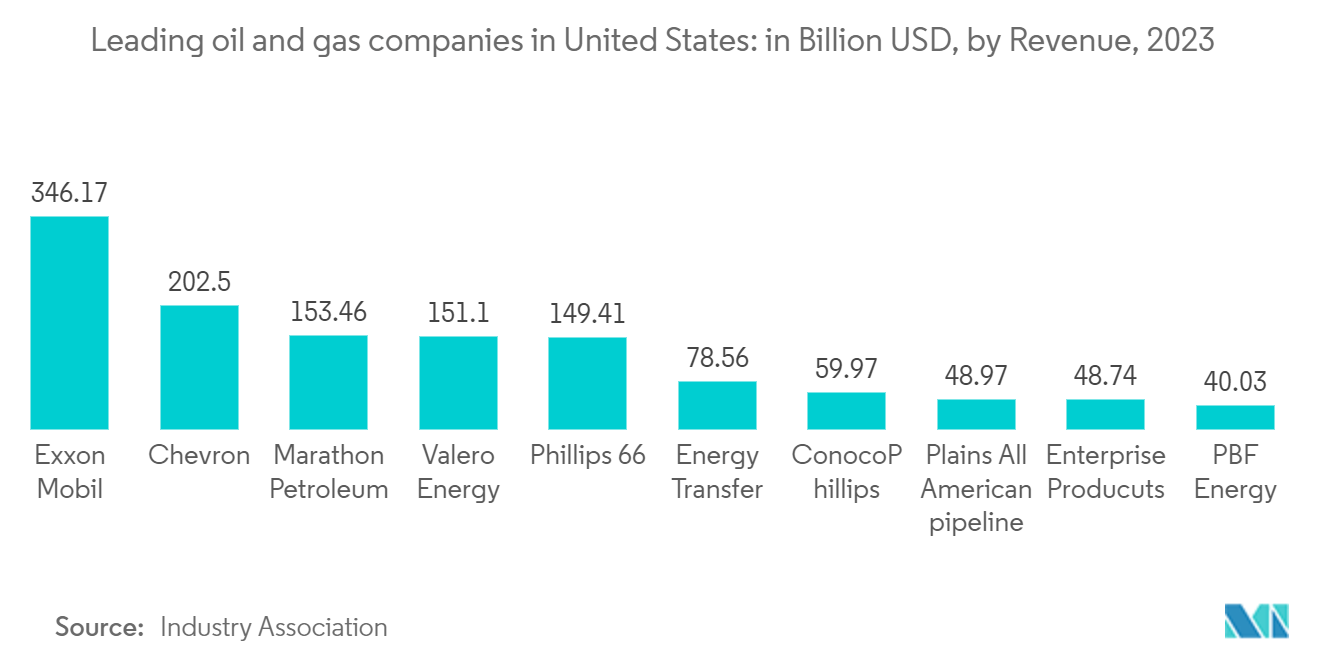
US Tank Trucking Industry Getting Benefited from Advanced Technologies
- In the past, US businesses have relied on tactics like increasing human resources and freight capacity, but supply chains have become more dynamic and customer-focused every day. It is using technology to create more autonomous and intelligent operations to overcome the industry's bottleneck.
- Businesses like Tesla and Alphabet's Waymo constantly develop AI systems to feed billions of miles of real-time data to AVs. Their goal is to make AVs that are fully autonomous at level 5. With or without a driver, tank trucks may soon be available at a moment's notice.
- A component of autonomous vehicle technology called platooning has the potential to end the ten-year truck driver shortage. Here, a group of self-driving vehicles would be closely linked (both physically and digitally), and supercomputers running AI would control these trucks from afar. As part of this project, Daimler has been building and testing a semi-autonomous vehicle that can now legally drive on Nevada's public roads.
- The US tank trucking business has become more productive and easier due to the improvements in satellite technology. Bill of lading information can be put into a simple dot matrix display screen showing only text. The "Qualcomm" system is also known as OmniTRACS.
- This enables communication between the driver and their dispatcher, who is often responsible for figuring out and telling the driver their drop-off and pick-up locations. Finding the next public phone is no longer necessary since American truck drivers may now communicate load status information while still within the truck cab.
- The driver uses a keyboard to enter the information into an automatic system of macro messages that have already been set up. The loading and unloading procedure has macros for each step, such as "arrived at the ultimate destination" or "loaded and leaving
- With this technology, the company can also keep track of the driver's speed, gear choice, location, engine idling time, driving time, and travel direction. Every truck in the United States is known as "a note on the system," according to the datasheet for the trucking business. This digital transparency is driving standards to transform the market globally, starting in the United States.
- Truck drivers who use GPS satellite navigation systems don't have to use a paper map, which saves them time and work. Drivers can listen to the news, sports, commercial-free music, and talk radio coast to coast without signal interruption if they are ready to pay for a satellite-operating radio or work for an organization that does. Thus, the government always puts money into the industry to help it grow.
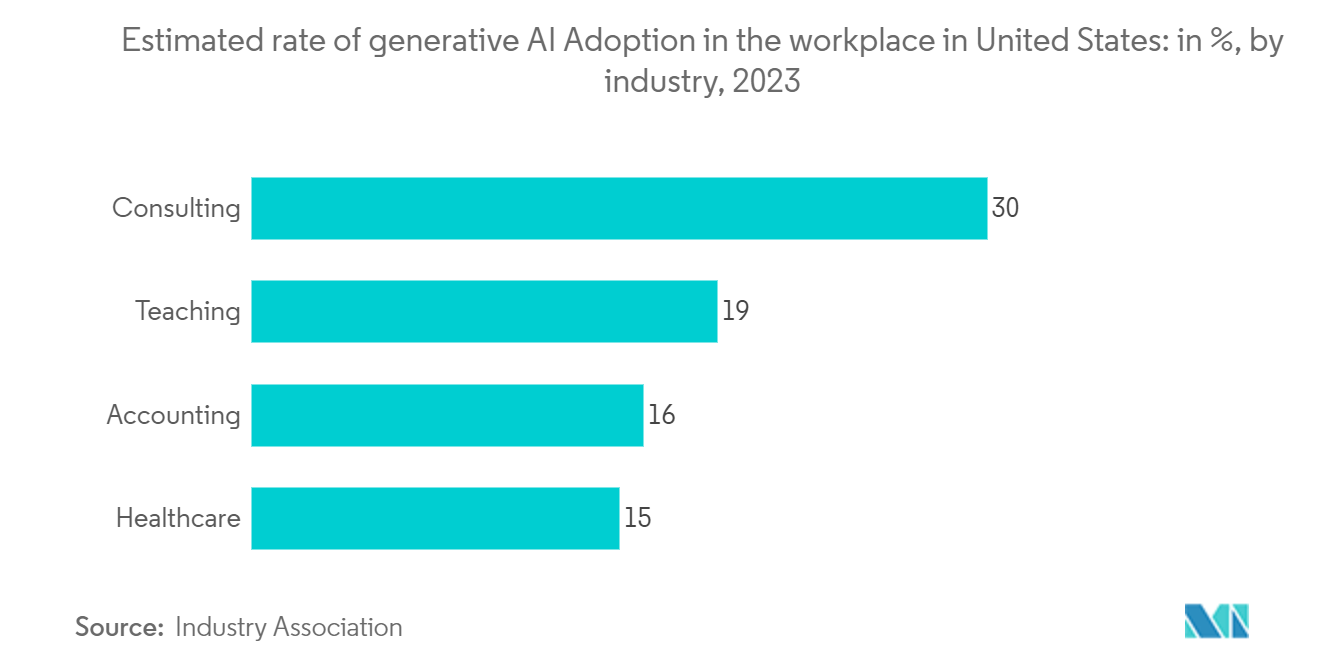
United States Tank Trucking Industry Overview
In the United States, there are a lot of small and medium-sized players in the tank trucking market, which makes it hard to tell who is the strongest. The market is also highly competitive. Driver scarcity or availability has a significant impact on a player's ability to generate revenue.
As technology changes the shape, size, and structure of parts, the US tank trucking business is also changing. Manufacturers are putting a lot of effort into making lightweight parts and components that are reliable and strong and help trucks work better. The US tank trucking market is growing, and new technologies like artificial intelligence are being used, which is expected to keep the market growing.
Power cars using fuel are also stored throughout the nation using tank trucks. The construction of these power car trucks is more durable and robust than that of other types of fuel tanks. Thus, these trucks are in high demand across the nation.
Some of the most important companies in the US tank trucking market are Kenan Advantage Group, Trimac Transportation Inc., Superior Bulk Logistics Inc., Martin Transport Inc., and Miller Transporters Inc.
Some other major players in the market are Dupre Logistics LLC, Foodliner/Quest Liner Inc., Ruan Transportation Management Systems, Groendyke Transport Inc., Tankstar USA, Eagle Transport Corp., Florida Rock & Tank Lines Inc., etc.
United States Tank Trucking Market Leaders
-
Kenan Advantage Group
-
Trimac Transportation Inc.
-
Martin Transport Inc.
-
Miller Transporters Inc.
-
Foodliner/Quest Liner Inc.
*Disclaimer: Major Players sorted in no particular order
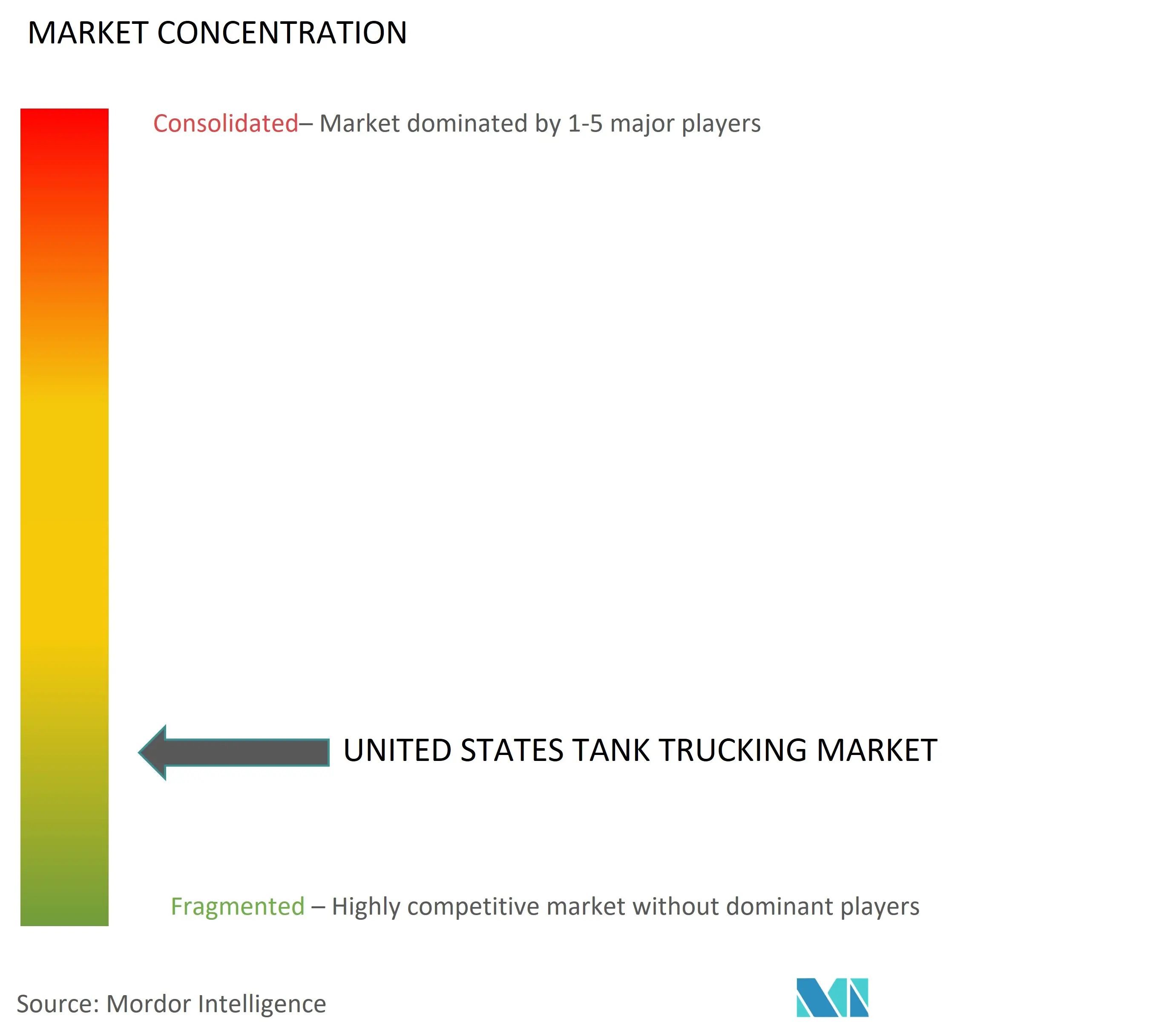
United States Tank Trucking Market News
- February 2024: Kenan Advantage Group, the largest tank truck transporter and logistics provider in North America, acquired Northern Dry Bulk, a company specializing in the transportation and storage of plastic resins for clients in the automotive, packaging, and electronics sectors across the United States and Canada. This acquisition brought 36 tractors, 91 trailers, and two terminals with two maintenance bays, along with warehouse space and trans-loading capabilities, into the KAG portfolio.
- April 2023: Trimac Transportation announced the acquisition of American Industrial Partners (AIP) Logistics, a Central Ohio-based company specializing in bulk terminal services, transportation, and warehousing for various industries, including plastics, liquid chemicals, food-grade storage, and metal production. AIP operates a fleet comprising 13 tractors and 119 trailers alongside other yard vehicular equipment. The 52-acre facility, situated in Wapakoneta, Ohio (18 miles south of Lima, Ohio), features cold, dry, and food-grade warehousing, bulk trans-loading, and storage facilities with access to the CSX Transportation rail line, as well as dry van, reefer, dry bulk, and bulk liquid transportation services.
US Tank Trucking Market Report - Table of Contents
1. INTRODUCTION
1.1 Study Deliverables
1.2 Study Assumptions
1.3 Scope of the Study
2. RESEARCH METHODOLOGY
3. EXECUTIVE SUMMARY
4. MARKET INSIGHTS
4.1 Current Market Scenario
4.2 Overview - US Trucking Industry (Analysis on Trucking Fleet, Demand, Goods Flow, and Emerging Trends)
4.3 Spotlight - Role of Transportation in the US Energy Sector
4.4 Insights on Intermodal Transport (Special Addendum on Rail Tank Transport)
4.5 Brief on Regulations and Safety
4.6 Review and Commentary on Freight Rates
4.7 Technology Snapshot - Trends and Automation
4.8 Impact of COVID-19 on the Market
5. MARKET DYNAMICS
5.1 Market Drivers
5.1.1 Rise in Demand for Oil and Natural Gas
5.1.2 Technological Advancements
5.2 Market Restraints
5.2.1 Increasing Regulatory Burden and Compliance Costs
5.2.2 Volatility of Fuel Prices
5.3 Market Opportunities
5.3.1 Rising Demand for Food Grade Transportation
5.4 Value Chain/Supply Chain Analysis
5.5 Industry Attractiveness - Porter's Five Forces Analysis
5.5.1 Threat of New Entrants
5.5.2 Bargaining Power of Buyers/Consumers
5.5.3 Bargaining Power of Suppliers
5.5.4 Threat of Substitute Products
5.5.5 Intensity of Competitive Rivalry
5.6 PESTLE Analysis
6. MARKET SEGMENTATION
6.1 By Fleet Type
6.1.1 For-hire
6.1.2 Private
6.2 By Capacity
6.2.1 Light Duty
6.2.2 Medium Duty
6.2.3 Heavy Duty
6.3 By Product Category
6.3.1 Crude Petroleum
6.3.2 Petroleum Products (Gasoline, Diesel, and Aviation Fuels)
6.3.3 Chemicals
6.3.4 Food and Beverages
6.3.5 Fertilizers
6.3.6 Other Product Categories
7. COMPETITIVE LANDSCAPE
7.1 Market Concentration Overview
7.2 Company Profiles
7.2.1 Kenan Advantage Group
7.2.2 Trimac Transportation Inc.
7.2.3 Superior Bulk Logistics Inc.
7.2.4 Martin Transport Inc.
7.2.5 Miller Transporters Inc.
7.2.6 Foodliner/Quest Liner Inc.
7.2.7 Dupre Logistics LLC
7.2.8 Groendyke Transport Inc.
7.2.9 Ruan Transportation Management Systems
7.2.10 Eagle Transport Corp
7.2.11 Tankstar USA
7.2.12 Florida Rock & Tank Lines Inc.*
- *List Not Exhaustive
7.3 Other Companies (Slay Transportation Co. Inc., Apex Logistics LLC, Mission Petroleum Carriers, Genox Transportation Inc., J&M Tank Lines Inc., CLI Transport LP, Tidewater Transit Co. Inc., Herman R Ewell Inc., Service Transport Company, Schilli Bulk Carriers Group, Andrews Logistics, and CTL Transportation LLC)
8. Future of the Market
9. Appendix
United States Tank Trucking Indsutry Segmentation
“Tank trucking" refers to the service used to transport liquids and gases, such as petroleum or oil, by road in tank trucks by tanker companies for industrial transportation. A tank truck is a special vehicle designed for moving goods, including vehicles, coal, oil, frozen food, iron ore, heavy machinery, gases, and other freight, that cannot be handled with regular box trailers. Owners of companies that provide long-distance, expert cargo transportation using trailers and trucks are included in the tank trucking industry.
The report provides a comprehensive background analysis of the US tank trucking market, covering the current market scenario, trends, drivers, restraints, technological updates, government regulations, and detailed information on various segments and the competitive landscape of the industry. In addition, the COVID-19 impact has been incorporated and considered during the study.
The market is segmented by fleet type (for-hire and private), capacity (light duty, medium duty, and heavy duty), and product category (crude petroleum, petroleum products (gasoline, diesel, and aviation fuels), chemicals, food and beverages, fertilizers, and other product categories). The report offers market size and forecasts for the US tank trucking market in value (USD billion) for all the above segments.
| By Fleet Type | |
| For-hire | |
| Private |
| By Capacity | |
| Light Duty | |
| Medium Duty | |
| Heavy Duty |
| By Product Category | |
| Crude Petroleum | |
| Petroleum Products (Gasoline, Diesel, and Aviation Fuels) | |
| Chemicals | |
| Food and Beverages | |
| Fertilizers | |
| Other Product Categories |
US Tank Trucking Market Research FAQs
How big is the United States Tank Trucking Market?
The United States Tank Trucking Market size is expected to reach USD 59.69 billion in 2024 and grow at a CAGR of 3.42% to reach USD 70.86 billion by 2029.
What is the current United States Tank Trucking Market size?
In 2024, the United States Tank Trucking Market size is expected to reach USD 59.69 billion.
Who are the key players in United States Tank Trucking Market?
Kenan Advantage Group, Trimac Transportation Inc., Martin Transport Inc., Miller Transporters Inc. and Foodliner/Quest Liner Inc. are the major companies operating in the United States Tank Trucking Market.
What years does this United States Tank Trucking Market cover, and what was the market size in 2023?
In 2023, the United States Tank Trucking Market size was estimated at USD 57.65 billion. The report covers the United States Tank Trucking Market historical market size for years: 2020, 2021, 2022 and 2023. The report also forecasts the United States Tank Trucking Market size for years: 2024, 2025, 2026, 2027, 2028 and 2029.
US Tank Trucking Industry Report
Statistics for the 2024 US Tank Trucking market share, size and revenue growth rate, created by Mordor Intelligence™ Industry Reports. US Tank Trucking analysis includes a market forecast outlook to 2029 and historical overview. Get a sample of this industry analysis as a free report PDF download.



